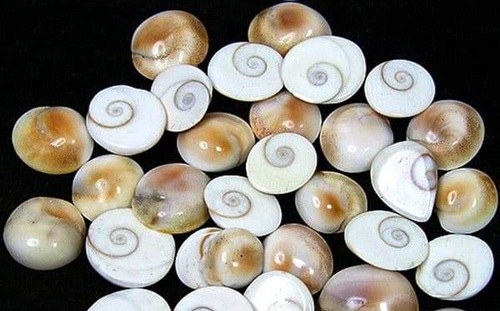In Indian tradition, the Gomti Chakra holds a special place for its spiritual and healing value. Found naturally in the Gomti River in Dwarka, Gujarat, these small, round stones are believed to bring prosperity, protection, and positive energy. They are often used in Vastu corrections, worn as talismans, or kept in homes and businesses. However, due to their high demand, fake or artificial Gomti Chakras are widely sold in markets. Knowing how to identify a real Gomti Chakra is important to ensure authenticity and receive its true benefits.

1. Understanding the Appearance
The first step in identification is observing the physical features:
- Shape: Real Gomti Chakras are round to oval in shape, resembling small shells.
- Color: They are typically off-white, pale yellow, or cream-colored. Some may have slight brown or gray marks.
- Natural Spiral: The most distinctive feature is the spiral (chakra) on one side. This spiral is naturally engraved, not artificially carved.
- Back Side: The reverse side is usually flat or slightly curved, unlike synthetic imitations which may look too smooth.
2. Surface and Texture
- A genuine Gomti Chakra has a smooth, natural polish due to water erosion, not machine-made shine.
- The spiral side may feel slightly raised when touched.
- Artificial versions often appear too glossy or have an unnatural shine.
3. Weight and Density
- Real Gomti Chakras are lightweight but firm when held in hand.
- Fake ones made of plastic or ceramic feel either too light and hollow or unusually heavy compared to natural ones.
4. Water Test
One of the simplest traditional methods:
- Place the Gomti Chakra in a glass of water.
- A real Gomti Chakra sinks immediately, as it is naturally formed calcium carbonate.
- Fake ones made of resin, plastic, or fiber often float on water.
5. Heat Test
- When exposed to mild heat, a genuine Gomti Chakra remains unchanged because it is stone-like in composition.
- A fake one may emit a smell of plastic or resin or show signs of melting.
6. Source and Authenticity
- Real Gomti Chakras are mainly collected from the Gomti River in Dwarka.
- Purchase only from trusted sellers or spiritual shops with a reputation for authenticity.
- If offered in unusually large sizes, perfect shapes, or bright artificial colors, they are likely fake.
7. Spiritual Energy Test (Believers’ Perspective)
Many practitioners believe that a genuine Gomti Chakra gives off a cool, calming energy when held in the palm. Fake versions, however, feel neutral and lack this subtle vibration. While this is subjective, devotees often use it as an additional indicator.
8. Difference Between Real and Fake Gomti Chakra
| Feature | Real Gomti Chakra | Fake Gomti Chakra |
| Spiral | Naturally engraved, uneven at times | Perfectly carved, machine-made |
| Shine | Natural dull shine | Overly glossy or polished |
| Water Test | Sinks | Floats |
| Heat Test | No change | Melts or gives smell of resin |
| Source | Found in Gomti River, Dwarka | Market-made using plastic or stone powder |
9. Practical Tips While Buying
- Avoid bulk purchases at very low prices—chances are high they’re fake.
- Check at least a few pieces carefully under natural light.
- Prefer raw, uneven pieces over overly “perfect” ones.
Final Thoughts
The Gomti Chakra is not just a decorative item but a symbol of faith, prosperity, and energy in Indian culture. Identifying the real one requires keen observation—look for the natural spiral, texture, weight, and water test results. With the rise of imitations in markets, being aware helps you avoid fraud and ensures you bring home the authentic spiritual stone that carries centuries of belief and tradition.